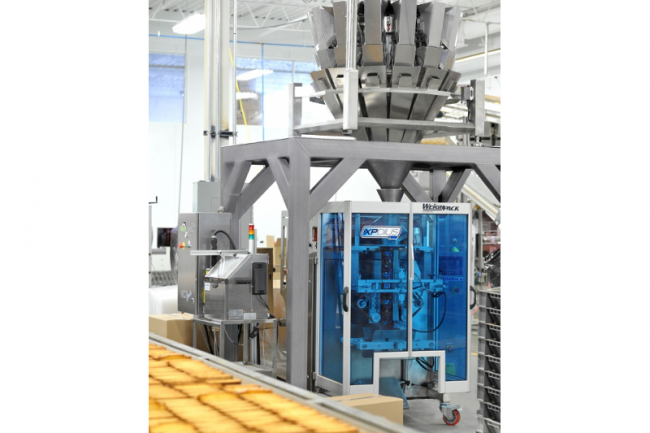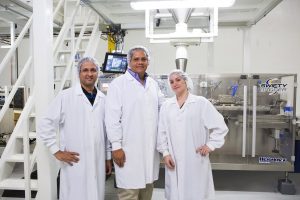This is a question we get asked all the time. Whether you’re a new business just starting out and have never bagged your product or you’re a seasoned operation that has just never automated the bagging process, the choices out there are seemingly endless. We’ll attempt to provide some clarity and hopefully answer questions you might have about this type of packaging machine.
So, what is a bagging machine?
Just look at your grocery store shelves. If it’s not in a wrapper, bottle or carton, chances are it’s in a bag. And even some of those items are placed in a bag after their initial packaging. Liquid or solid, food or component, medical or pharmaceutical, you will find bagging machines in a variety of configurations based on product size and weight.
A pouch filling machine can open your premade bag and then both close and seal the bag after your product is deposited. Other bagging machines will form, cut and seal from a roll of film to produce the bag. Either way, this is just one step of the overall packaging process. There is a pre-filling stage where your product is weighed or counted and prepared for bag filling and then there is usually some process for moving the bags after they are filled including conveying, labeling, check weighing, case filling and even palletizing.
What do you mean by premade bag versus a roll of film?
If you are already bagging your product, then this one is easy, so bear with us for a second. A premade bag, or pouch, is fully formed on three sides and just needs to be filled and sealed prior to moving on to the next step of the packaging process. A bag made from a cylindrical roll of film needs to be formed, filled and sealed on 3 or 4 sides prior to the next step. Each type of machine has its advantages. The amount and consistency of your product may dictate which process you need, and one machine may work better than another with some products. Cost and facility space issues can also be important factors.
How can I tell the difference?
You’ll know a premade pouch filling machine because there is no place to load a roll of film onto a spindle. Instead, premade bags are conveniently loaded into the machine from a magazine that can be adjusted to the allowable minimum and maximum bag sizes. A vertical form, fill and seal machine (VFFS) or a horizontal form, fill and seal machine (HFFS) needs a spindle to handle a roll of film equal to the maximum bag width the machine can accommodate. They will also have a noticeable collar, shaped somewhat like a plow, to open the flat film into a fillable shape.
What is the optimal bagging machine for me?
It really depends on several factors. Here are a few variables to consider:
- Budget. In general, the entry price for a premade pouch filler and a VFFS machine are competitive while an HFFS machine entry price will be higher. Keep in mind that the price of a premade bagging machine does not account for the additional cost of premade packaging. You will typically pay 30% more for your premade pouches than you will for roll stock film. And while you may have some packaging waste while you fine-tune the size of the bag made with a VFFS or HFFS machine, premade pouches require more inventory space and can be left unused if you move to a different size bag. Make sure you research the minimum and maximum bag sizes and speeds each type of machine can handle when it comes to your product. Make sure to factor in material costs and potential savings based on each machine type.
- Complexity. The good news is most packaging machines do not require highly skilled operators once they’ve received comprehensive training. But they will require a higher level of technical expertise within your operation for ongoing maintenance and adjustments. With that said, an HFFS machine is typically a larger, servo-driven unit capable of producing a larger variety of bag and pouch styles within one machine. The ability to produce and seal your own 3-sided, 4-sided, pillow or stand-up DOY pouches of varying sizes at high-speed with options like zipper closure and spout insertion can make these machines well worth the higher price if you need that flexibility. But that does not mean premade pouch filling machines and VFFS machines are not complex or cannot deliver high production rates, they are typically more specialized in terms of bag size, type and speed. They may be more affordable and consistent options for smaller operators just starting out. They may also be useful for those with a uniquely shaped premade pouch or a need to bag larger or heavier product that only a larger VFFS machine can accommodate.
- Speed. Most reputable packaging machine suppliers have a variety of VFFS, HFFS and premade baggers that can produce up to 50 packages per minute. Some may even have models that fill up to 100 packages per minute. If speed is a priority for your company, be realistic about your bags type, desired size and end weight. If a supplier has a machine in each category that can accommodate your product at the size, weight and speed you need, then what are your other criteria? Cost? Appearance? Sanitization? While VFFS and HFFS machines can generally deliver higher speeds, make sure that speed really is the most important factor for you, all other factors being equal.
- Your Product. Let’s say, just as an example, you need to fill 30 pounds of dog food into a bag. Chances are you won’t be using a premade pouch filler that can typically only handle a bag 10-12 inches wide. You’ll need a bagging machine that can allow you to fill a wider bag with heavier material that can be appropriately sealed and that’s probably a job for a VFFS machine. On the other hand, if you need to fill small pet treats into a stand-up resealable bag, a 10- or 12-inch bag width may work just fine so you need to look at the other machine variables like budget, complexity and speed.
- Marketing. Since premade pouch filling machines utilize predesigned and precut pouches, you can expect a consistent, attractive package for your product every time. You can also expect the same precision out of the larger HFFS machines since they can typically replicate the complexity of premade pouches with roll stock film. But with an HFFS machine, you also have the flexibility to vary the shape, seal and form of your bags within the maximum allowable width without having to buy a separate inventory of bags. Also keep in mind that many packaging machine manufacturers feature custom machines for side-loading product into premade bags, such as wrapped bars for the snack food industry. There are also machines to fill and vacuum seal premade wicket bags as commonly seen in foodservice packaging for fresh produce and meat.
What Else Is There?
These are just a few our observations about automatic bagging machines and some of the factors to consider before purchasing your machine. You should also make sure to factor in considerations such as:
- Labor savings,
- Access to service tools and maintenance plans,
- Availability of spare parts,
- Ease of changeover,
- Facility space and layout; and,
- Supplier reputation and longevity in the industry.
And maybe there are other factors on your list we have not thought of. Weigh them all out and then make the decision that is right for your product and your future.

Learn More About Your Options
If you still need help, we’re here for you. We’re good listeners. And we’re pretty good solvers too. We have a 30-year record of problem-solving sessions and free consultations typically resulting in long-lasting partnerships. We would be honored to help you build a bagging solution for your product.
From our Swifty Bagger line of premade pouch filling solutions to our VerTek and XPdius VFFS machines or our high-performance R2B HFFS machine, we have the automated bagging options to help your operation be more productive and save resources. Let’s start a partnership today.
